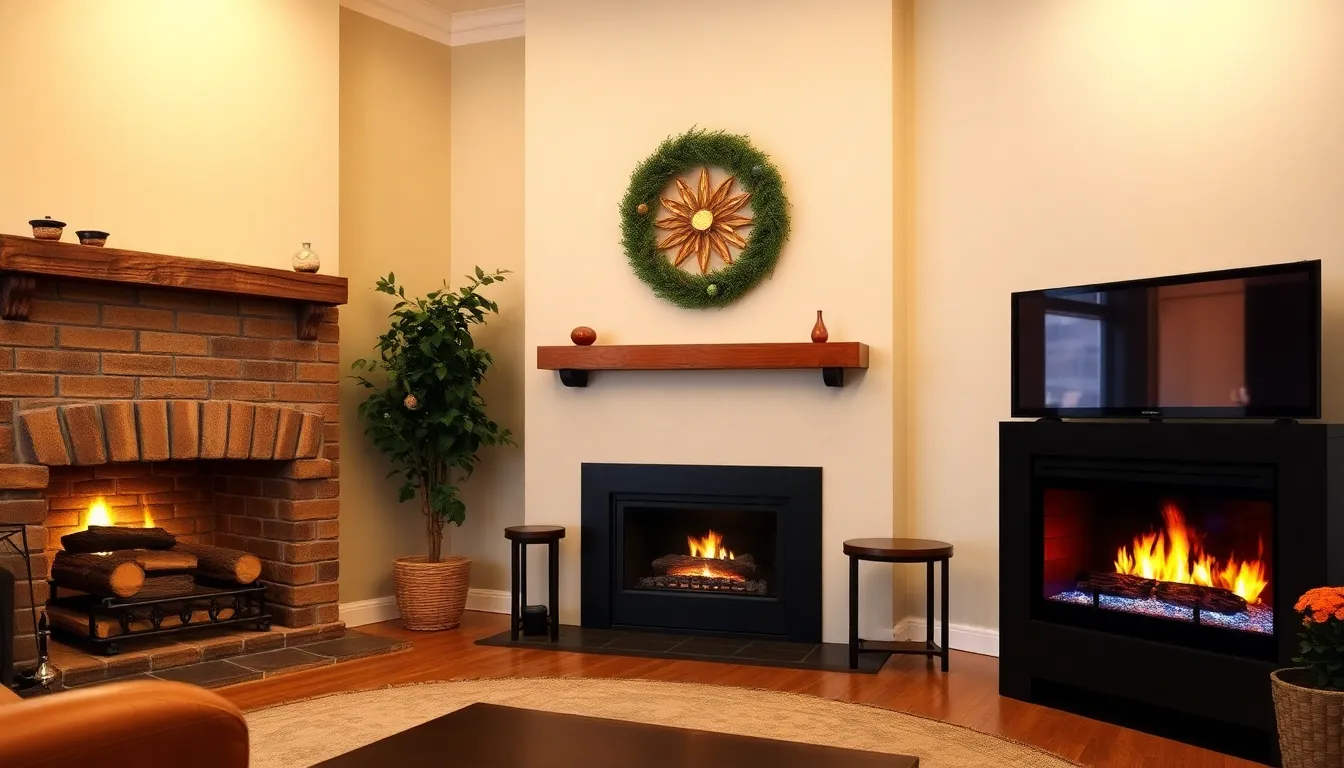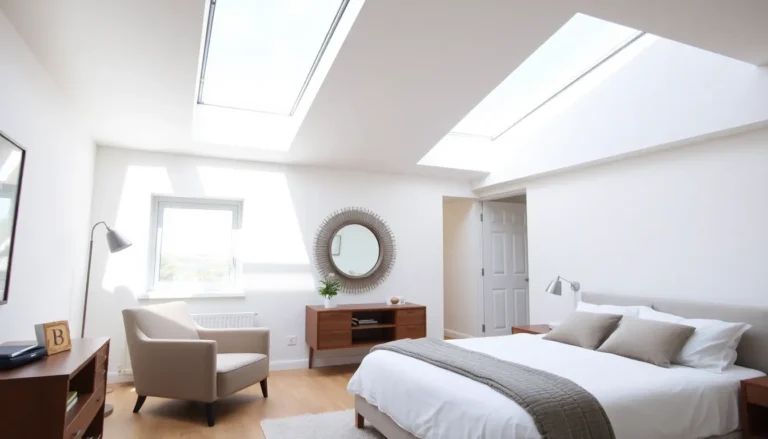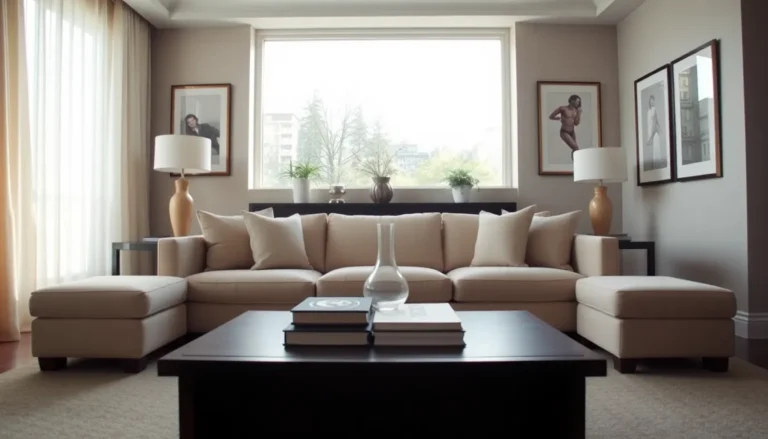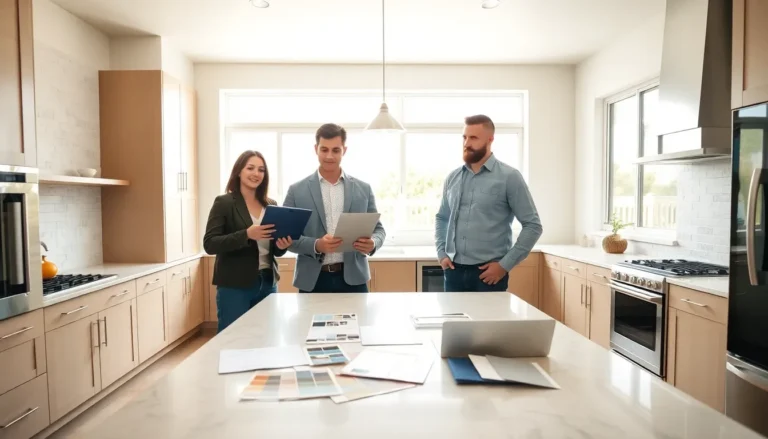Imagine curling up on a chilly evening, hot cocoa in hand, as the crackling warmth of a fireplace dances in the background. Sounds cozy, right? But before you can bask in that bliss, there’s a small hurdle: fireplace installation. It’s not just about picking out the prettiest mantel; it’s about transforming your space into a haven of warmth and style.
Table of Contents
ToggleOverview of Fireplace Installation
Fireplace installation encompasses a series of important steps that transform a living space. Choosing the right fireplace type is essential. Traditional wood-burning units provide classic appeal, while gas models offer convenience and efficiency. Electric fireplaces offer simplicity and ease of installation. Each type presents its own advantages and drawbacks.
Assessing the space is crucial before starting the installation process. Room dimensions and existing infrastructure play significant roles. Ventilation requirements also differ based on the selected fireplace type. Understanding building codes ensures compliance and safety during installation.
Selecting the right materials impacts both aesthetics and functionality. Hearth materials include stone, tile, or brick, each enhancing the overall design. A qualified contractor can guide choices and ensure quality craftsmanship. Installation typically requires expertise, especially when integrating electrical or gas lines. Safety measures, such as proper sealing and venting, minimize risks.
Preparation involves several key tasks. Clearing the designated area removes obstacles and ensures a clear work environment. Gathering necessary tools and materials promotes efficiency. Following the manufacturer’s instructions is vital for a successful installation.
Care and maintenance are integral after installation. Regular inspections ensure optimal performance and safety. Cleaning the fireplace annually prevents creosote buildup in wood-burning models. Gas fireplaces require checking connections and functionality to maintain efficiency.
Throughout the process, understanding personal preferences shapes decisions. Do preferences lean towards modern designs or classic styles? Priorities in functionality, efficiency, and aesthetics guide homeowners in creating their ideal space.
Types of Fireplaces

Fireplaces come in various styles and functionalities. Understanding the differences helps in making an informed choice for any space.
Wood-Burning Fireplaces
Wood-burning fireplaces produce a classic ambiance. These units use logs for fuel, creating a crackling fire that enhances warmth. Maintenance includes cleaning the chimney to prevent creosote buildup. Efficiency varies, often depending on the design and the type of wood used. Some models also feature a firebox, improving heat retention. Despite requiring more work than others, the traditional appeal remains a favorite among many.
Gas Fireplaces
Gas fireplaces combine convenience with efficiency. They utilize either natural gas or propane as fuel sources, providing a steady flame at the push of a button. Safety features like automatic shut-off valves enhance user confidence. Cleaning involves minimal effort, usually requiring occasional dusting. Some models mimic the look of wood-burning fires with realistic logs. The option to control the flame height appeals to those seeking customizable warmth.
Electric Fireplaces
Electric fireplaces offer the ultimate simplicity for homeowners. They plug into standard outlets, requiring no venting or gas lines. Most models feature LED technology that produces realistic flames. Ease of installation adds to their appeal, as they can fit almost any room. Maintenance is minimal, often just routine cleaning of the exterior. Many electric options include heater settings for year-round use, making them a versatile choice for any living space.
Preparation for Installation
Preparation ensures a smooth and successful fireplace installation. This process involves careful planning of location and ventilation systems.
Choosing the Right Location
Selecting an ideal location for the fireplace significantly enhances comfort and aesthetics. Consider existing features such as focal points in the room. Ensure distance from combustible materials when determining placement. A central location often improves heat distribution throughout the space. Factor in access to existing fuel sources, especially for gas or wood-burning units. Lastly, evaluate the room’s layout to maintain optimal functionality and visual appeal.
Assessing Ventilation Needs
Proper ventilation is essential for safe and efficient fireplace operation. Assess nearby windows and doors to enhance airflow. Check local building codes to ensure compliance with ventilation requirements. Install necessary vents to allow fresh air circulation and exhaust harmful gases. An expert can assist in evaluating existing ductwork or recommend additional solutions. Addressing ventilation early in the process helps prevent future issues related to indoor air quality and safety.
Installation Process
Successful fireplace installation requires a detailed approach. Attention to tools and materials ensures a seamless process.
Tools and Materials Needed
Essential tools include a drill, level, measuring tape, and safety goggles. Important materials consist of the fireplace unit, flue pipe, venting kit, and approved insulation. Additionally, screws, brackets, and caulk contribute to proper assembly and sealing. Homeowners benefit from having a stud finder and fireproof sealant on hand for enhanced safety. A professional-grade adhesive is advisable for securing components.
Step-by-Step Installation Guide
Start by measuring the space for accurate placement of the fireplace. Afterward, mark the installation location on the wall. Cut necessary openings for venting before securing the fireplace unit in position. Ensure all connections align with the manufacturer’s specifications, particularly regarding gas or electric lines. Proceed to install the venting system, making sure it complies with local building codes. Finally, test the fireplace for functionality and safety before using it. Regular inspections enhance performance and ensure safety over time.
Safety Considerations
Safety is paramount in fireplace installation. Understanding and adhering to codes and regulations ensures proper installation and peace of mind.
Building Codes and Regulations
Building codes govern fireplace installation and can vary based on location. Most municipalities require permits to ensure compliance with safety standards. Check local regulations for guidelines on chimney height, clearance from combustibles, and venting requirements. Ignoring these codes may lead to fines or unsafe conditions. Homeowners rely on certified professionals to navigate these regulations effectively, ensuring a legally compliant and safe installation. Engaging local authorities for inspections can prevent future issues, providing an additional layer of safety.
Maintenance Tips
Regular maintenance is essential for fireplace safety and efficiency. Inspecting the chimney once a year prevents dangerous creosote buildup and ensures proper function. Homeowners should clean the hearth and surrounding area frequently to minimize fire hazards. Testing smoke and carbon monoxide detectors monthly keeps the family safe. Assessing vents ensures unobstructed airflow, contributing to optimal performance. Scheduling professional inspections helps identify problems before they escalate, maintaining a safe environment. Prioritizing these maintenance tasks significantly reduces risks associated with fireplace use.
A well-installed fireplace can be the centerpiece of any home providing warmth and comfort during cold evenings. By carefully considering the type of fireplace materials and proper ventilation homeowners can create a safe and inviting atmosphere. Engaging qualified professionals ensures compliance with local building codes and enhances the installation process.
Regular maintenance and inspections are crucial for safety and efficiency keeping the fireplace in optimal condition. Prioritizing these steps not only enhances the fireplace’s performance but also contributes to peace of mind. With thoughtful planning and execution a fireplace can truly transform a living space into a cozy retreat.





